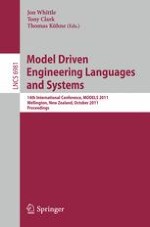This book constitutes the refereed proceedings of the 14th International Conference on Model Driven Engineering Languages and Systems, MODELS 2011, held in Wellington, New Zealand, in October 2011. The papers address a wide range of topics in research (foundations track) and practice (applications track). For the first time a new category of research papers, vision papers, are included presenting "outside the box" thinking. The foundations track received 167 full paper submissions, of which 34 were selected for presentation. Out of these, 3 papers were vision papers. The application track received 27 submissions, of which 13 papers were selected for presentation. The papers are organized in topical sections on model transformation, model complexity, aspect oriented modeling, analysis and comprehension of models, domain specific modeling, models for embedded systems, model synchronization, model based resource management, analysis of class diagrams, verification and validation, refactoring models, modeling visions, logics and modeling, development methods, and model integration and collaboration.
